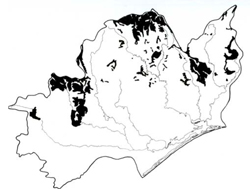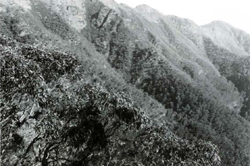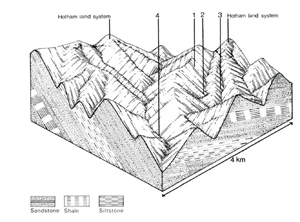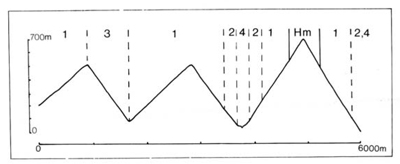Birregun (Be)
 | Area: 1968 sq. km (9.7%) Birregun land system is particularly extensive, occurring on Ordovician. Devonian and Silurian sediments in the upper parts of the East Victorian Uplands, below the subalpine tract. The terrain is mountainous with ridge and-ravine topography and long, steep slopes on which soil creep and other slope processes are active. Birregun land system is similar in geography and topography to Talbotville land system but is much more humid and has associated differences in the vegetation and soils. This environment with high rainfall, steep slopes and active slope processes has tended to produce leached. uniformly-textured soils, which are often stony, shallow, permeable, well structured and moderately acidic. Most of the vegetation is shrubby or layered open forest II or III, with open forest I or II on lower, drier slopes. |  Mountain slopes clearly showing the characteristic ridge-and-ravine topography |
| CLIMATE Rainfall, mean (mm) Temperature, mean (°C) Seasonal growth limitations |
Annual 900 - 1600; lowest January or February (50 - 90), highest August or September (120 - 180) Annual 8 - 12; lowest July (3 - 7), highest February (16 - 20) Temperature <10°C (av.): April - October Rainfall < potential evapotranspiration: February; frequent winter snow |
| GEOLOGY Age, lithology |
Ordovician, Silurian and Devonian siltstones, sandstones and shales; minor proportion lightly metamorphosed |
| PHYSIOGRAPHY Landscape Elevation range (m) Relative relief (m) Drainage pattern Drainage density (km/km2) |
Steep mountains with ridge-and-ravine topography 180 - 1600 180 - 740 Dendritic 1.4 |
| PRESENT LAND USE |
|
 |  |
| LAND COMPONENT Percentage of land system Diagnostic features | 1 75 Slopes with humid forest (non-ash species) | 2 10 Slopes, usually at lower elevations, with drier forest | 3 10 Protected slopes with alpine or mountain ash | 4 5 Discontinuous terraces along major streams |
| PHYSIOGRAPHY Slope %, typical and (range) Slope shape | 30 - 50. (25 - 80) Straight | 30 - 50, (25 - 80) Straight | 40 - 50, (30 - 100) Straight | <5, (0 - 10) Straight |
| SOIL | ||||
| Parent material | Siltstone, sandstone and shale | Coarse textured alluvium | ||
| Description | Black to very dark loam to sandy clay loam merging into greyish brown or brown sandy clay loam to light clay: mostly shallow and very stony | Similar to component 1, but often less shallow and subsoil more reddish | Similar to component 1, but generally deeper and surface soil often with more humus and darker coloured | Limited observations — mainly very dark loamy sand to sandy loam; stony |
| Classification | Lithosols, Brown Earths Um1.23, Um1.44, Um5.51. Um6.23, Um6.24. Um7.11, Gn3.21 | Red Earths. Lithosols, Brown Podzolics Um6.12, Um6.24, Db1.21 | Brown Earths, Lithosols, some Alpine Humus Soils at higher elevations Um6.14, Um6.21, Um6.23, Um7.11, Uc6.14, Gn4.11 | Alluvial Soils Uc1.21, Uc5.21 |
| Surface texture | Loam to sandy clay loam | Loamy sand to sandy loam | ||
| Surface consistence | Soft to slightly hard | Soft to slightly hard | ||
| Depth (m) | Extremely variable; 0.2 - 1.5 | <2.0 | ||
| Nutrient status | Low | Low | ||
| Available soil water capacity | Moderate | Moderate | ||
| Perviousness to water | Rapid | Rapid | ||
| Drainage | Good | Good | ||
| Exposed stone (%) | Very variable; 0 - 60 | Variable | ||
| Sampled profile number | - | 7 | - | - |
| NATIVE VEGETATION Structure of vegetation and characteristic species of dominant stratum (+ Predominant species) | Shrubby or layered open forest II, III: Usually mixed forests with composition and predominant species variable — E. cypellocarpa, E. dives. mannifera. E.obliqua, E. rubida | Open forest 1, II: Pure or mixed stands of E. dives, E. sieberi, E. obliqua; E. mannifera sometimes associated | Shrubby or layered open forest III: Higher elevations — E. delegatensis+, occasionally with E. dives+, and/or E. rubida+ Lower elevations — E. regnans (presumed) | Shrubby open forest II: Variable composition, commonly E. rubida+ or E. viminalis+ with or without E. radiata+ |
Disturbance | Affected process and trend | Primary resultant deterioration | Casual activities | Primary off-site process | ||
Form | Susceptibility of components | Incidence with components | ||||
— reduction in leaf area, rooting depth and/or perenniality — reduction in density of tree roots | Reduced transpiration, resulting in: a) increased deep percolation and leaching b) increased regolith wetness Decreased root-binding |
|
|
Common Common |
|
|
| Increased overland flow and soil detachment | Sheet and rill erosion | 1.2,3: high | Uncommon | Clearing, logging, burning, overgrazing, road building and other earth-moving activities. | Increased flash flows and sediment load. |
| Increased compaction With reduced infiltration | Structure decline Sheet and rill erosion | 12.3.4: low - moderate 1.2.3: high | Uncommon Uncommon | Increased trafficking, overgrazing, export of organic matter As for sheet and rill erosion above | - Increased flash flows and sediment load |
| Increased soil break-up | Gully erosion
Streambank erosion | 1,2,3: high 4: high | Uncommon Uncommon | As for sheet and rill erosion above As for sheet and rill erosion above | Increased sediment load Increased turbidity of streams |
| Comments: Regeneration of vegetative cover is generally rapid because of adequate rainfall, but is limited at higher elevations | ||||||


